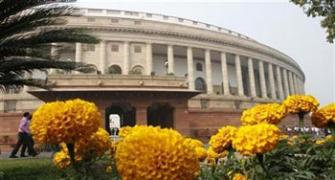The rise in freight rates will not impact the common man as the commodities that will be affected are also supplied at subsidised rates, say A K Mital, chairman, and Rajalakshmi Ravikumar, financial commissioner of the Railway Board. Excerpts from a media interaction:

What has been the focus of this year's Railway Budget?
The bulk of Indian Railways' (IR's) traffic runs on six corridors that connect the four metro cities and the diagonals of this quadrilateral.
These six corridors are completely choked. We are not able to increase the passenger trains and the freight trains and our punctuality is getting affected.
Even if a single train gets delayed, it creates a cascading affect. Budget 2015: Complete Coverage
So, the focus of the Railway Budget this year is to increase the capacity of the system, to decongest the network.
The other focus areas are customer convenience, safety and becoming self-sustained. Our dependence on Gross Budgetary Support (GBS) should not increase to such a level that we are unable to operate without it.
This year, for the first time, we have laid a road map for five years which says we will spend Rs 8.5 lakh crore during this period. This year, we will spend Rs 1 lakh-crore (Rs 1 trillion), a 52 per cent jump over the Rs 65,000 crore (Rs 650 trillion) in the previous year.
This means the Railways will spend Rs 1.5-2 lakh crore (Rs 1.5-2 trillion) every year.
This will result in a 20 per cent increase in track length.
Also, our passenger carrying capacity will increase from 21 million a day to 30 million a day and freight tonnage from 1.1 billion tonnes to 1.5 billion tonnes.
From where do you plan to raise this money and how?
Of the Rs 1 lakh-crore to be spent in 2015-16, Rs 40,000 crore will come from the finance ministry as GBS, Rs 1,645 crore (Rs 16 from diesel cess, Rs 17,793 crore (Rs 177.93 billion) from my internal resources and the balance Rs 40,000 crore from external borrowing. We had Rs 13,000 crore of external borrowing in last year's Budget.
To pay back these external borrowings, we have identified the projects which will give us the money to service this debt. That is why we are looking at partnerships with state governments, public sector units, multilateral agencies and private parties.
All of this will give us around Rs 17,000 crore and another Rs 17,000 crore from IRFC (Indian Railway Finance Corporation) borrowings and an additional Rs 6,000 crore from PPP (public-private partnerships).
How will you spend this money?
Last year, we had spent only Rs 4,000 crore on doubling (track). This expenditure is going to go up to Rs 18,000 crore in 2015-16, a 357 per cent jump. This will be adopted wherever the line capacity is being utilised by more than 100 per cent. We will also improve signaling and lay more lines.
Overall, Rs 96,000 crore will be spent on increasing the capacity. That will include initiatives like gauge conversion.
Could you clear the confusion surrounding the freight rate increase?
We have changed the slab rates and classification for different commodities.
After the restructuring of the slabs, the rate is seen rising by a maximum of 10 per cent in a few commodities and even dipping to negative numbers in certain others.
Overall, we will get Rs 4,000 crore from the exercise out of the budgeted Rs 1,21,423 crore of freight earnings.
Therefore, the average rise has been close to three per cent.
For the first time in its history, IR is attempting an annual incremental growth in freight tonnage by 85 mt as compared to 50 mt additional freight growth every year in the past.
The freight rise will not impact the common man as the commodities witnessing these - including foodgrain and fertiliser - are also supplied at subsidised rates.
The bulk of this investment would be directed at doubling and tripling of existing tracks, along with gauge conversion to increase the railways' loading capacity.
This decongestion will allow us to increase our annual freight tonnage. It will also reduce the requirement of rolling stock. Today, we are running Rajdhani trains, normal passenger trains and even goods trains on the same track.
Given the dip in diesel prices, how do you see IR's fuel bill growing next year?
Fuel is only 25 per cent of working expenses. In freight, the bulk of our movement is on electric traction. We are doing two things - bringing down our energy usage by adopting measures to boost energy efficiency and a switch to buying electricity from generating companies through an open bidding system, to cut costs.
Currently, we buy electricity from State Electricity Boards.
This is one reason why we have been able to project an improved Operating Ratio.
We are also expecting a significant growth in earnings, particularly in freight.










